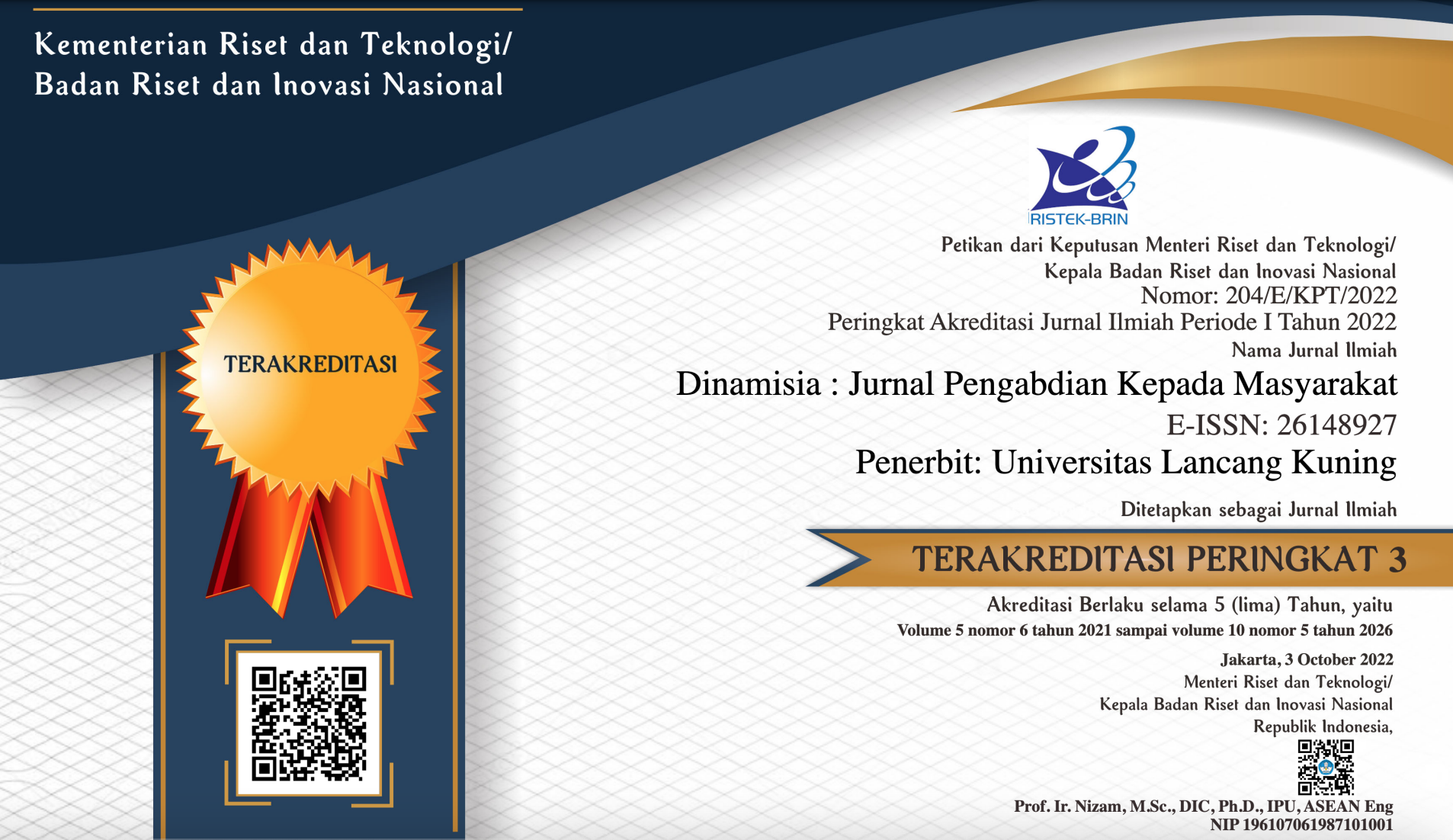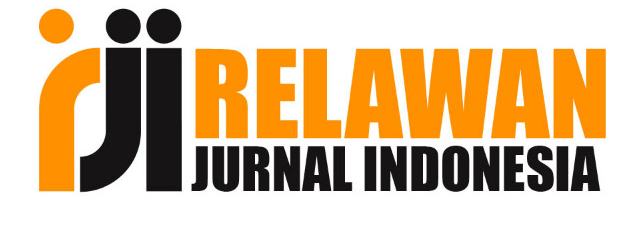Pengurangan Penggunaan Plastik Pada UMKM Perkampungan Wisata Budaya Betawi Setu Babakan Jakarta
Abstract
This program objection for assisting the government's efforts to reduce the plastics using in Indonesia, especially in South Jakarta. The expected benefit of the activity is the increasing of enviromental care insight by suppressing the plastic wrap using for small business unit in the Betawi Cultural Tourism Setu Babakan Village South Jakarta. The activity was counseling and discussion. The target audience was small and micro business units. The programme results are 92 percent of participants will suppress the use of plastic as a wrapper and 8 percent still do not have the desire to suppress the use of plastic wrap. 92 percent of them will try to apply the green marketing concept and there are still 8 percent who do not want to apply this concept. Ninety seven percent of participants stated that this activity provided benefits and increased understanding of reducing plastics using and the concept of green marketing.
Downloads
References
Badan Pusat Statistik. (2018). Statistik Lingkungan Hidup Indonesia (SLHI) 2018. Badan Pusat Statistik/BPS–Statistics Indonesia, 1–43. https://doi.org/3305001
Bank Indonesia. (2013). Kajian Kesiapan UMKM Ramah Lingkungan Dalam Mendapatkan Akses Pembiayaan.
Dewi, A. P., & Yesti, Y. (2018). Pengujian Biodegradasi Filem Plastik Campuran Polimer Sintetis ( Polistiren ) Dan Biopolimer. Prosiding Seminar Nasional Fisika Universitas Riau Ke-3 2018, (29 September 2018), 76–82.
DKI Jakarta. Peraturan Daerah Provinsi Daerah Khusus Ibukota Jakarta No. 3 Th. 2013, jakarta.go.id § (2005).
Fitriah, I., Yusup, I. R., Fujiarti, I. A., Sudarmika, I., & Ramadhanty, L. (2019). Potensi Bencana Dibalik Volume Sampah Anorganik Dalam Kegiatan Perkuliahan. Jurnal Bio Educatio, 4(4), 95–105.
Hahladakis, J. N., Velis, C. A., Weber, R., Iacovidou, E., & Purnell, P. (2018). An overview of chemical additives present in plastics: Migration, release, fate and environmental impact during their use, disposal and recycling. Journal of Hazardous Materials, 344, 179–199. https://doi.org/10.1016/j.jhazmat.2017.10.014
Haryono, A., Astrini, N., & SR, W. (2001). Sintesa Polistirena Sulfonat Sebagai Koagulan Polimer. In Prosiding Simposium Nasional Polimer IV ISSN 1410-8720 (Vol. 2, pp. 61–66).
Hayati, N., & Suryasih, I. A. (2019). Strategi Pengelolaan Kampung Betawi Setu Babakan Sebagai Daya Tarik Wisata Di Jakarta Selatan. Jurnal Destinasi Pariwisata, 7(1), 105. https://doi.org/10.24843/jdepar.2019.v07.i01.p16
Indrianti, N. (2016). Community-based Solid Waste Bank Model for Sustainable Education. Procedia - Social and Behavioral Sciences, 224(August 2015), 158–166. https://doi.org/10.1016/j.sbspro.2016.05.431
Karuniastuti, N. (2016). BAHAYA PLASTIK. Forum Teknologi, 03(1), 6–14.
Kementerian Keuangan RI, (2019) ‘Media Keuangan Transparansi Infoemasi Informasi Kebijakan Fiskal’, Media Keuangan, XIV(144), pp. 1–30.
Peraturan Pemerintah Indonesia,. (2017). Kebijakan Dan Strategi Nasional Pengelolaan Sampah Rumah Tangga Dan Sampah Sejenis Sampah Rumah Tangga, 1–15. Retrieved from https://peraturan.bpk.go.id/Home/Details/73225/perpres-no-97-tahun-2017
Pelley, J. (2018). Plastic Contamination of the Environment: Sources, Fate, Effects, and Solutions. American Chemical Society, 11.
Permata Dewi, A., & Yesti, Y. (2018). Pemanfaatan Limbah Plastik Menjadi Kemasan Ramah Lingkungan Serta Uji Biodegradasinya. JOPS (Journal Of Pharmacy and Science), 1(2), 33–38. https://doi.org/10.36341/jops.v1i2.492
Purwaningrum. (2016). Upaya Mengurangi Timbulan Sampah Plastik. Jurnal Teknik Lingkungan, 8(2), 141–147. Retrieved from https://www.trijurnal.lemlit.trisakti.ac.id/urbanenvirotech/article/view/1421
Sahwan, F. L. et al. (2005) ‘Sistem Pengelolaan Limbah Plastik di Indonesia’, Jurnal Sistem Pengolahan Limbah J. Tek. Ling. P3TL-BPPT, 6(1), pp. 311–318.
Septiani, B. A., Arianie, D. M., Risman, V. F. A. A., Handayani, W., & Kawuryan, I. S. S. (2019). PENGELOLAAN SAMPAH PLASTIK DI SALATIGA: Praktik, dan tantangan. Jurnal Ilmu Lingkungan, 17(1), 90. https://doi.org/10.14710/jil.17.1.90-99
Suminto, S. (2017). Ecobrick: solusi cerdas dan kreatif untuk mengatasi sampah plastik. PRODUCTUM Jurnal Desain Produk (Pengetahuan Dan Perancangan Produk), 3(1), 26. https://doi.org/10.24821/productum.v3i1.1735
Suryani, L., Aje, A. U., Tute, K. J., Flores, U., Studi, P., Informatika, S., … Universitas, I. (2019). Kabupaten Ende Dalam Pegelolaan Limbah Organik Dan Anorganik Berbasis 3R Untuk Mengeskalasi Nilai, 3(2), 1–8.
Wardany, K., Sari, R. P., & Mariana, E. (2020). Sosialisasi Pendirian “ Bank Sampah ” Bag i Peningkatan, 4(2), 364–372.
www.greenpeace.org.
Yana, S., & Badaruddin. (2017). Pengelolaan Limbah Plastik Sebagai Upaya Pengurangan Pencemaran Lingkungan Melalui Transformasi Yang Memiliki Nilai Tambah Ekonomi. Serambi Engineering, II(4), 157–164.



















